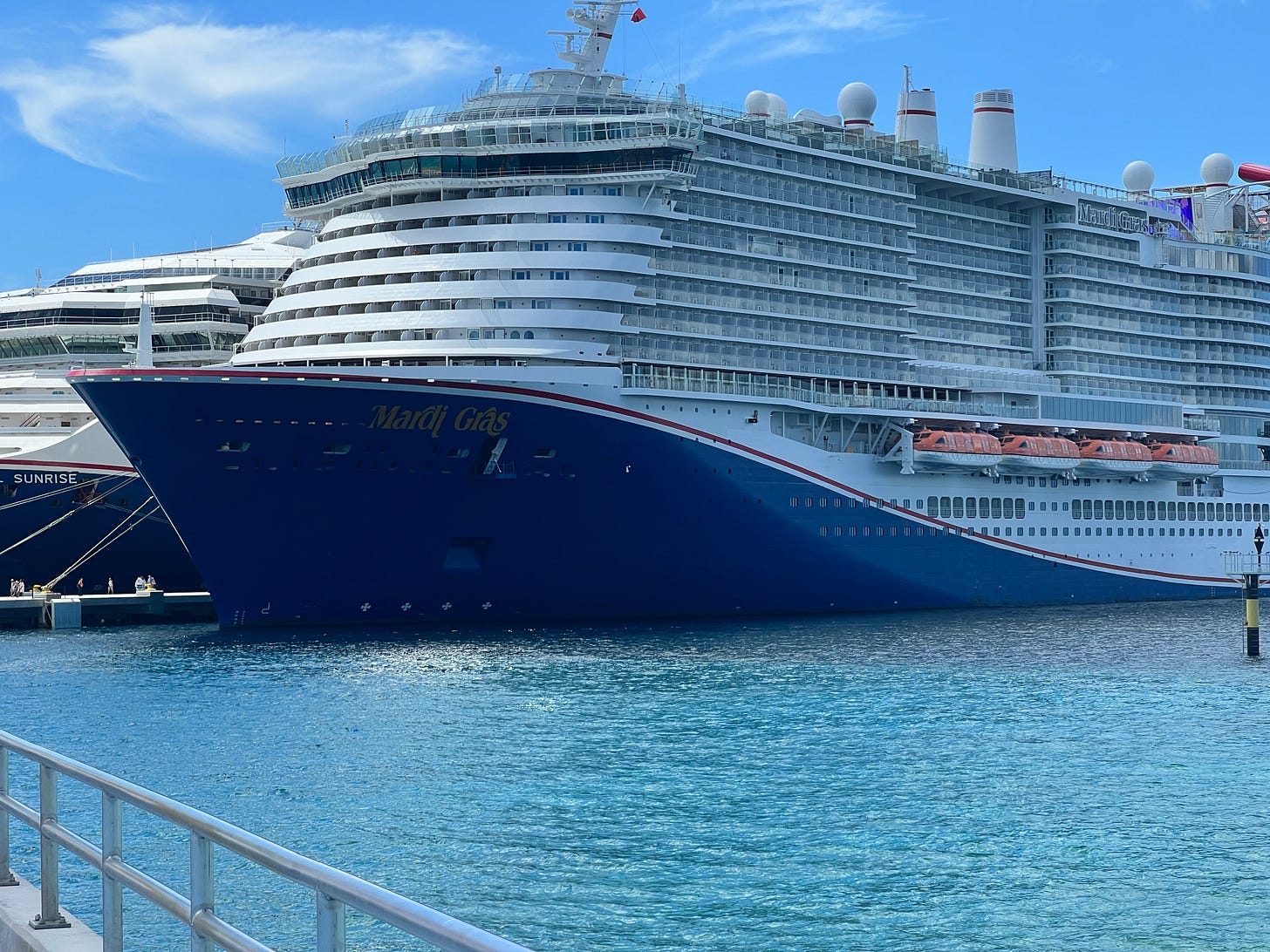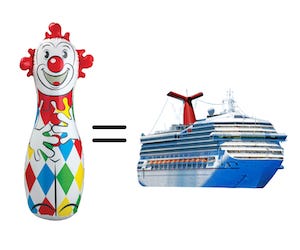The Dangers of a Floating City
why I tried to sink a 200,000-ton ship
There are a lot of things in life I don’t understand, and therefore find it hard to believe. Like how a plane can lose one, or even both engines, and still land safely. Or how skyscrapers can sway several feet in the wind, and that’s what makes them safe.
Or how a 19-story building can stay afloat. That’s the one currently on mind. Driving up to the Carnival Mardi Gras, my eyes pertnear popped out of my head, and I thought, “No way! There’s no way that thing’s not tipping over. Especially when the roller coaster runs out over the side of the ship and back again. You have to be kidding me!”
So I did what any anxious person with any sense would do, and I researched.
Turns out it’s all about the weight. The weight is what actually keeps these ships from tipping over! Down low, beneath the waterline, are the engines, fuel, freshwater, and wastewater tanks, stabilizers, and even special empty tanks that can be filled with seawater when more weight is needed.
In the old days, ships literally carried stones or sandbags in the bottom of the hull. Not to make them float, but to keep them steady. It’s the same story with Weebles, who wobble but don’t fall down: the heavy weight at the bottom always pulls them upright whenever they tip, making them invincible (to tipping). I mean, you can’t tip the things, remember? Well, that’s exactly what the heavy stuff at the bottom of the ship, or the ballast, does. It’s the weight low and hidden that keeps the ship steady.
That’s different than how my brain pictured it. I imagined a strong gust shoving the whole thing sideways like an umbrella in a storm. But unlike an umbrella, most of a cruise ship’s weight sits hidden beneath the surface—so the wind can’t budge it.
So what would it take to flip one over? Something that’s never happened to a cruise ship: a wave taller than the ship itself, hitting it square in the middle, at the exact wrong angle, while all the laws of physics take a day off.
In other words, my anxious brain may imagine it, but engineers have already planned for it. Yep, turns out waves can only do so much. The ocean can make the ship rock, roll, and even slam, but the whole design is to move with the waves instead of resisting them. If you’ve ever tried to knock over one of those giant punching clowns weighted with sand, you’ve already done the physics experiment. So when you think cruise ship, think clown! (And cue the circus music in your head—everything is less overwhelming with the circus music playing.)
But punching clowns don’t erase the other image most of us carry, like the Titanic. It haunts us. But the Titanic didn’t ‘tip over’—ships don’t just casually fall over. They sink because they take on water in the wrong places. And modern ships are built with watertight compartments and redundant systems to keep that from happening.
Yeah, so that explains why a cruise ship won’t tip, but what keeps this beast afloat, I wondered? Because a Weeble on the carpet will wobble forever, but drop it in water and it sinks like a stone. And we’re not talking about a toy ship — this one is 200,000 tons of cruising steel. Shouldn’t it sink to the bottom faster than a dime in a wishing well?
To that, the wise old internet told me that, unlike jumping into a kiddie pool—where the water rises up the sides and spills out to get away from you—the ocean doesn’t have walls or edges to overflow. So, when the ship presses down, it shoves water molecules aside, obviously. But here’s something I didn’t know: water can be moved, but it can’t be squashed smaller. Just think about that. It’s incompressible. So the only option is for the water to push back against the hull with equal force. And that push is what keeps the ship floating. 💡
Awesome news! But you know me, I don’t stop at the physics. My brain always drifts into the metaphysics. And the metaphor is great with this one. Just look back at the parts I bolded, and think about them with their spiritual weight in mind.
Like a cruise ship, made for the ocean, placed on dry land would tip over, we were made for grace. Grace always rises to meet the weight we carry. It doesn’t get used up, drained out, or squashed smaller. You can move in it, rock in it, even feel the waves of it—but you can’t diminish it. Just as water can’t be compressed, grace can’t be reduced. It won’t run thin when pressed by the full weight of your life. It always rises to meet what you bring.
And the weight, or the ballast, is like faith. Faith doesn’t make you float—grace does. But faith is what steadies you inside that grace. Without faith, you’d still be surrounded by grace, but you’d be like a ship adrift—tossed and turned by every wave, with nothing to hold you upright (Eph. 4:14). Faith is what roots you and holds you steady (Col. 2:7). And without the water of grace, the weight of your faith would topple you like a ship on dry land. You need both, and they work together—weight deep within and water all around—to keep you steady and held (Rom. 5:2).
So when I feel like I’m about to tip, I remind myself: I was made for grace. The water always holds. My ballast may wobble, but grace won’t run dry. And together, they’ll keep me steady until the storm passes.
“Through him we have also obtained access by faith into this grace in which we stand, and we rejoice in hope of the glory of God.” (Romans 5:2)




